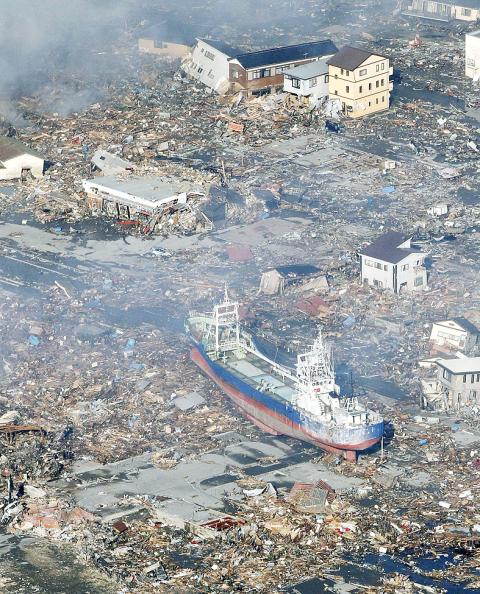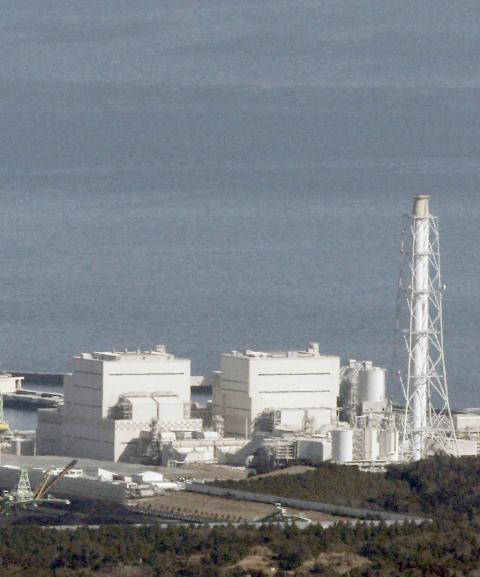An explosion and feared meltdown at a Japanese nuclear plant yesterday exposed the scale of the disaster facing the country after a massive quake and tsunami left more than 1,000 dead.
Japanese Prime Minister Naoto Kan said the magnitude 8.9 quake and the terrifying tsunami that followed were an “unprecedented national disaster” and vowed to protect those living near the stricken plant.
Reactor cooling systems failed at two nuclear facilities after Friday’s record earthquake, which unleashed a terrifying 10m tsunami that tore through coastal towns and cities, destroying everything in its path.

Photo: Reuters
Smoke was seen billowing from the Fukushima No. 1 atomic plant about 250km northeast of Tokyo after an explosion at the site.
Kyodo News agency said radioactive caesium had been detected near the aging facility, citing the nuclear safety agency.
However, Kan’s top spokesman, Yukio Edano, said that the Fukushima plant’s operator had reported the reactor container was not damaged and that radiation levels near it had fallen after the blast.

Photo: Reuters
Kyodo and Jiji reported before the explosion that the plant “may be experiencing nuclear meltdown,” while public broadcaster NHK quoted the safety agency as saying metal tubes that contain uranium fuel may have melted.
The cooling system of the plant was damaged in the massive earthquake that struck the region 24 hours earlier, leaving authorities scrambling to fix the problem and evacuate tens of thousands of people within a 20km radius.
Thousands were evacuated near another damaged plant, Fukushima No. 2.
The atomic emergency came as the country struggled to assess the full extent of the devastation wreaked by the massive tsunami, which was unleashed by the strongest quake ever recorded in Japan.
The wall of water pulverized towns and cities along the northeastern coast. Police reportedly said 200 to 300 bodies had been found in the city of Sendai.
About 300 to 400 bodies were recovered in Rikuzentakata, a coastal town of about 23,000 people, NHK quoted the military as saying.
The Fire and Disaster Management Agency said the tsunami had obliterated the town.
It was not immediately clear whether any of the bodies found by the military were included in police tolls showing at least 700 people dead. The government spokesman said at least 1,000 people were believed to have lost their lives.
More than 215,000 people were huddled in emergency shelters, police said.
The full scale of those left homeless was believed to be much higher, with police saying they had not received a tally from Miyagi Prefecture, the hard-hit region that is home to Sendai.
NHK reported that about 10,000 people are unaccounted for in the Japanese port town of Minamisanriku in Miyagi. The figure is more than half of the town’s population of about 17,000, it said.
Local authorities are trying to find their whereabouts with the help of Japan’s Self-Defense Forces, NHK said.
The raging tsunami picked up shipping containers, cars and the debris of shattered homes. It crashed through the streets of Sendai and across open fields, forming a mud slick that covered vast tracts of land.
“There are so many people who lost their lives,” an elderly man told TV reporters before breaking down in tears. “I have no words to say.”
Authorities said more than 3,000 homes were destroyed or swept away.
About 50,000 military and other rescue personnel were spearheading a Herculean rescue and recovery effort with hundreds of ships, aircraft and vehicles headed to the Pacific coast area.
Army helicopters airlifted people off the roof of an elementary school in Watari, Miyagi Prefecture.
In quake-hit areas, 5.6 million households had no power yesterday and more than 1 million households were without water. Telecommunications networks were also hit.
The quake, which hit at 2:46pm and lasted about two minutes, rattled buildings in greater Tokyo, the world’s largest urban area and home to about 30 million people.
More than 24 hours after the first, massive quake struck about 400km northeast of Tokyo, aftershocks were still rattling the region, including a strong magnitude 6.8 tremor yesterday.
The US Geological Survey said more than 100 aftershocks had hit the area.

‘CHARM OFFENSIVE’: Beijing has been sending senior Chinese officials to Okinawa as part of efforts to influence public opinion against the US, the ‘Telegraph’ reported Beijing is believed to be sowing divisions in Japan’s Okinawa Prefecture to better facilitate an invasion of Taiwan, British newspaper the Telegraph reported on Saturday. Less than 750km from Taiwan, Okinawa hosts nearly 30,000 US troops who would likely “play a pivotal role should Beijing order the invasion of Taiwan,” it wrote. To prevent US intervention in an invasion, China is carrying out a “silent invasion” of Okinawa by stoking the flames of discontent among locals toward the US presence in the prefecture, it said. Beijing is also allegedly funding separatists in the region, including Chosuke Yara, the head of the Ryukyu Independence

UNITED: The premier said Trump’s tariff comments provided a great opportunity for the private and public sectors to come together to maintain the nation’s chip advantage The government is considering ways to assist the nation’s semiconductor industry or hosting collaborative projects with the private sector after US President Donald Trump threatened to impose a 100 percent tariff on chips exported to the US, Premier Cho Jung-tai (卓榮泰) said yesterday. Trump on Monday told Republican members of the US Congress about plans to impose sweeping tariffs on semiconductors, steel, aluminum, copper and pharmaceuticals “in the very near future.” “It’s time for the United States to return to the system that made us richer and more powerful than ever before,” Trump said at the Republican Issues Conference in Miami, Florida. “They

GOLDEN OPPORTUNITY: Taiwan must capitalize on the shock waves DeepSeek has sent through US markets to show it is a tech partner of Washington, a researcher said China’s reported breakthrough in artificial intelligence (AI) would prompt the US to seek a stronger alliance with Taiwan and Japan to secure its technological superiority, a Taiwanese researcher said yesterday. The launch of low-cost AI model DeepSeek (深度求索) on Monday sent US tech stocks tumbling, with chipmaker Nvidia Corp losing 16 percent of its value and the NASDAQ falling 612.46 points, or 3.07 percent, to close at 19,341.84 points. On the same day, the Philadelphia Stock Exchange Semiconductor Sector index dropped 488.7 points, or 9.15 percent, to close at 4,853.24 points. The launch of the Chinese chatbot proves that a competitor can

‘VERY SHALLOW’: The center of Saturday’s quake in Tainan’s Dongshan District hit at a depth of 7.7km, while yesterday’s in Nansai was at a depth of 8.1km, the CWA said Two magnitude 5.7 earthquakes that struck on Saturday night and yesterday morning were aftershocks triggered by a magnitude 6.4 quake on Tuesday last week, a seismologist said, adding that the epicenters of the aftershocks are moving westward. Saturday and yesterday’s earthquakes occurred as people were preparing for the Lunar New Year holiday this week. As of 10am yesterday, the Central Weather Administration (CWA) recorded 110 aftershocks from last week’s main earthquake, including six magnitude 5 to 6 quakes and 32 magnitude 4 to 5 tremors. Seventy-one of the earthquakes were smaller than magnitude 4. Thirty-one of the aftershocks were felt nationwide, while 79